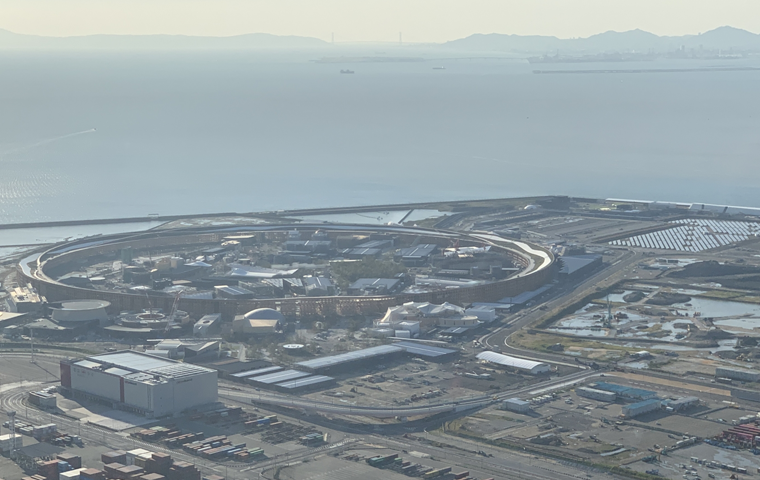The Door to the Future Opens: The Osaka Expo Finally Begins
Related Articles
On April 13, 2025, amid global anticipation and excitement, the Expo 2025 Osaka, Kansai, Japan opened its doors—launching a 184-day journey into the future. Under the theme “Designing Future Society for Our Lives,” this grand celebration brings together 161 countries and nine international organizations on the man-made island of Yumeshima in Osaka Bay. More than 140,000 visitors had reserved entry for the opening day, and long lines formed at the newly opened subway station leading to the venue from the early morning, reflecting the feverish enthusiasm that had already gripped the public before the gates opened.
At the press preview, visitors were greeted by the Grand Roof Ring, one of the world’s largest wooden structures, designed by architect Sou Fujimoto. Its monumental form evoked a gateway to the future. People strolling atop the ring, audiences mesmerized by shows of water and light, and drone performances painting the night sky—all combined to create a deeply festive atmosphere.
The official mascot, “Myaku-Myaku,” had already become a national sensation, drawing crowds eager to take photos. The character’s popularity has translated into booming merchandise sales—now seen as a key revenue pillar alongside ticket income, projected to help the Expo reach a 28-billion-yen surplus by its conclusion.
However, beneath the dazzling opening lay a number of practical challenges. Five national pavilions—including those of India and Chile—failed to complete interior construction in time, and opening week saw issues such as mobile ticket display outages and long queues at popular attractions. These growing pains underscored both the immense difficulty of realizing such an ambitious vision and the powerful dynamism driving the project forward. Imperfect though it may be, the Osaka Expo has set off as a “magnificent but unfinished celebration”—a symbol of progress forged through perseverance.
The Vision of a “Laboratory for the Future Society”
At its core, the Expo is far more than a showcase of exhibits—it is conceived as a “Living Lab,” an experimental arena where visitors can experience technologies and social systems of the future in real operation.
The most anticipated symbol of this concept is the commercial test operation of flying cars. Major groups such as ANA Holdings and Japan Airlines (JAL) have been selected to operate air routes connecting the Expo site with Kansai International Airport and downtown Osaka, marking a historic leap from laboratory testing to real-world use of next-generation urban mobility.
Another major pillar is the Osaka Healthcare Pavilion, which envisions the future of health and medicine. Visitors will meet a digital avatar of themselves 25 years in the future, generated from their health data, and experience personalized healthcare and lifestyle simulations. This pavilion highlights Japan’s leadership in medical science and proposes a model for a sustainable, longevity-oriented society.
Sustainability runs through the entire Expo, guided by the EXPO 2025 Green Vision, which aims for decarbonization and a circular economy. For example, the Japan Pavilion operates under the concept of a “pavilion that eats waste,” incorporating a plant that converts food scraps from the venue into biogas. This biogas is then synthesized with renewable hydrogen to create e-methane, used to fuel gas systems across the site—achieving localized energy production and recycling.
To curb food waste, the “Expo Tabesuke” food-sharing platform enables visitors to buy surplus food at discounted prices. These measures transform the abstract ideal of sustainability into tangible, participatory experiences. Unlike past Expos that showcased finished technologies, the Osaka Expo invites the world to witness and engage in the process of creating the future itself—a truly living experiment in progress.
The Road to Opening: Overcoming Repeated Challenges

Behind the glittering opening lay a long and turbulent road, marked by obstacles so serious that the Expo’s realization borders on the miraculous. The greatest hurdle was its soaring costs. Initially estimated at 125 billion yen, construction expenses ballooned to 235 billion yen—nearly double—due to a combination of factors: global material price inflation, labor shortages driving up wages, and the weakening yen. The cost is shared equally among the national government, Osaka Prefecture and City, and the private sector, sparking public scrutiny over the use of tax money.
More alarming than cost overruns was the delay in the “Type A” pavilions, which are built by participating countries themselves. By mid-2023, not a single nation had submitted construction permit applications to Osaka City, raising fears that the event might be postponed. The crisis stemmed from structural issues in Japan’s construction industry: rising costs, and the introduction of new overtime regulations in April 2024, which further constrained tight construction schedules.
Many contractors hesitated to accept loss-making foreign pavilion projects, prompting the Expo Association to propose a “prebuilt pavilion” system—constructing simplified buildings on behalf of countries. Ultimately, around-the-clock work was required to meet deadlines, drawing concerns over labor conditions.
These issues reflected not only event management challenges but broader economic and social strains—from workforce shortages to inflation—now confronting Japan. The very site of the Expo, Yumeshima, was itself a point of controversy: a reclaimed island built from industrial waste and construction debris, requiring extensive ground reinforcement to prevent liquefaction. Adjacent to the Expo grounds, plans for Japan’s first integrated resort (IR) including a casino fueled criticism that massive public investment in infrastructure was effectively subsidizing private development.
That the Expo overcame these hurdles to open on time stands as a major test—and testament—of Japan’s national project execution capability.
Beyond 1970’s Legacy: Japan’s New Image to the World

The 1970 Osaka Expo was a defining event of Japan’s postwar economic miracle. People flocked to see the Moon Rock displayed at the U.S. Pavilion, while artist Taro Okamoto’s “Tower of the Sun” became an enduring symbol of that era’s optimism.
Over half a century later, the 2025 Osaka Expo aims to create a new, 21st-century legacy. With an estimated economic ripple effect of 2 trillion yen and an expected 28.2 million visitors, it is positioned to reinvigorate inbound tourism and further boost Japan’s recovery from the pandemic—especially in the Kansai region.
Yet this Expo seeks to achieve more than economic gains or monumental structures. Its deeper mission lies in fostering intangible “soft legacies”—enhancing urban brand value, promoting global exchange, and projecting Japan’s cultural soft power. Events themed around anime, manga, and other Cool Japan content aim to deepen global fan engagement and sustain tourism beyond the Expo.
Amid an era of division and conflict, Expo 2025 also carries a geopolitical message of solidarity. Perhaps its most symbolic presence is the Ukrainian Pavilion, established despite the ongoing war. Its theme, “Not For Sale,” delivers a powerful statement: a nation’s dignity, culture, and lives are not commodities. Exhibits include war-damaged objects such as air raid sirens, confronting visitors with the stark realities of conflict. The Belgian Pavilion even provided its space for Ukrainian events, demonstrating how the Expo can serve as a platform for international unity.
Thus, the Osaka Expo is not merely a festive gathering but a global forum for dialogue and shared reflection amid turbulent times. If the 1970 Expo showcased Japan as a “technological superpower,” then the 2025 Expo seeks to present a mature Japan—one that contributes to solving global challenges, captivates the world through cultural creativity, and stands in solidarity with nations in distress. It marks Japan’s reemergence as a nation not only of innovation, but of empathy, wisdom, and global responsibility.



